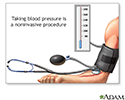Noninvasive
The term noninvasive can refer to diseases, procedures, or devices.
- Noninvasive diseases usually do not spread to or damage other organs and tissues.
- Noninvasive procedures do not involve tools that break the skin or physically enter the body. Examples include x-rays, a standard eye exam, CT scan, MRI, ECG, and Holter monitoring.
Standard eye exam
A standard eye exam is a series of tests done to check your vision and the health of your eyes. This exam is performed by an ophthalmologist or opto...
 ImageRead Article Now Book Mark Article
ImageRead Article Now Book Mark ArticleCT scan
A computed tomography (CT) scan is an imaging method that uses x-rays to create pictures of cross-sections of the body. Related tests include:Abdomin...
 ImageRead Article Now Book Mark Article
ImageRead Article Now Book Mark ArticleMRI
A magnetic resonance imaging (MRI) scan is an imaging test that uses powerful magnets and radio waves to create pictures of the body. It does not us...
 ImageRead Article Now Book Mark Article
ImageRead Article Now Book Mark ArticleECG
An electrocardiogram (ECG) is a test that records the electrical activity of the heart.
 ImageRead Article Now Book Mark Article
ImageRead Article Now Book Mark ArticleHolter monitoring
A Holter monitor is a machine that continuously records the heart's rhythms. The monitor is worn for 24 to 48 hours during normal activity.
 ImageRead Article Now Book Mark Article
ImageRead Article Now Book Mark Article - Noninvasive devices include hearing aids, external splints, and casts.
Splints
A splint is a device used to hold a part of the body stable to decrease pain and prevent further injury.
 ImageRead Article Now Book Mark Article
ImageRead Article Now Book Mark Article
Noninvasive is the opposite of invasive.
Invasive
An invasive disease is one that spreads to surrounding tissues. An invasive procedure is one in which the body is "invaded", or entered by a needle,...
References
National Cancer Institute website. www.cancer.gov/publications/dictionaries/cancer-terms/def/noninvasive. Accessed January 7, 2025.
-
Noninvasive test - illustration
A noninvasive test is a procedure that does not involve tools that break the skin or physically enter the body.
Noninvasive test
illustration
Review Date: 1/1/2025
Reviewed By: Linda J. Vorvick, MD, Clinical Professor Emeritus, Department of Family Medicine, UW Medicine, School of Medicine, University of Washington, Seattle, WA. Also reviewed by David C. Dugdale, MD, Medical Director, Brenda Conaway, Editorial Director, and the A.D.A.M. Editorial team.


